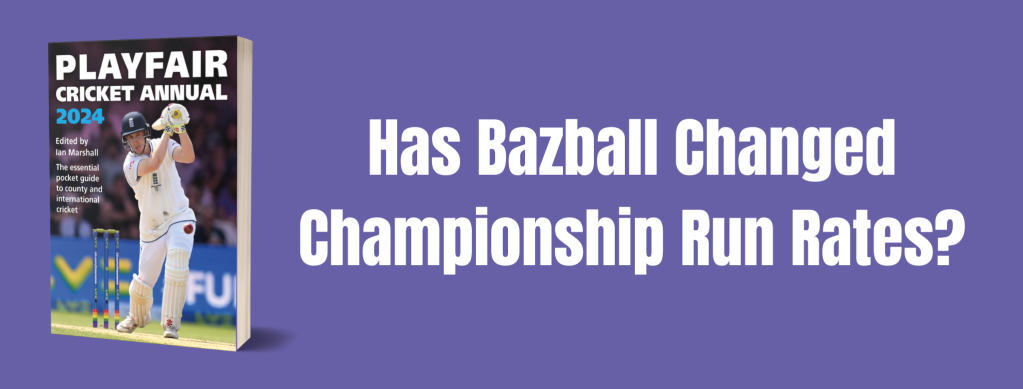Has Bazball Changed Championship Run Rates?

In this year’s Foreword, I commented that bowlers seemed to have bowled fewer maidens in 2023 than in 2022 – without fully checking that the facts supported my assertion. But now I can confirm that this was correct, at least as far as Division One went. So why might this have been?
Tallying up the bowling figures for the eight counties that played in both seasons, so we’re comparing like with like, we find a few noticeable changes. First of all, there were just 2907 maidens bowled between them in 2023, compared with 3495 the previous season – a hefty fall of almost 17%. However, the number of overs bowled by the eight teams also fell, from 16,944 in 2022 to 14,676.4 in 2023 (more than 13%). So whereas in 2022 there was a maiden every 4.85 overs, in 2023 it was one every 5.05 overs – a more modest 4% decline in frequency.
Unsurprisingly, therefore, the bowlers were conceding more runs, up from 3.09 per over in 2022 to 3.26 in 2023 – an increase of 5.5%. So not only were bowlers unable to bowl six consecutive dot balls as easily, they were conceding more runs, too. The ECB will have been pleased by this, because a rule change for how bonus points were awarded meant that sides needed to score 50 runs more in the first 110 overs for each point received. Whereas previously 200 runs gave a side their first point, now it was 250; while the maximum tally of five points was achieved only when 450 runs were scored, not 400.
But did another factor come into play, too: Bazball? With the England selectors clearly prioritising shot-makers and risk-takers over those who grind down the opposition, maybe batters recognised that taking the positive option was the best way to be noticed. Bowlers certainly felt the force of this: only Kent (whose bowlers conceded runs at 3.58 in 2022 and 3.54 in 2023) and Warwickshire (from 3.28 to 3.15) saw their economy rates improving, while Lancashire’s bowlers had the biggest increase, with their overs going for 3.06 in 2023 compared to 2.64 the season before. One can expect Nathan Lyon to have an impact on that stat in 2024.
So does this mean that these nudges towards positive cricket worked? Certainly, more games were won and lost – 46 out of 70 in the First Division in 2023, compared to 45 in 2022 – but the difference is negligible. Meanwhile, the number of wickets taken by bowlers in our eight teams fell by 2.5%, from 1699 to 1655. However, once you take into account the number of overs bowled, it means that bowlers’ strike rates actually improved, from one every 9.97 overs to one every 8.86 overs (up by 12.5%). Overall, bowlers’ averages improved from 30.78 in 2022 to 28.90 last year.
In short, you could say that the County Championship became more frenetic: higher run-rates, fewer maidens and more frequent wickets – all of which created a small increase in decisive match outcomes. As such, the Championship reflected what has been going on under Ben Stokes, where his 24 matches as England captain have resulted in just one draw. Among all of England’s Top 30 longest-serving captains, no other skipper has had as few draws under their leadership.
With ever-increasing opportunities for white-ball cricket meaning that innovative strokeplay is brought across into the red-ball game, coupled with the new points structure and the incentive to catch the selectors’ eye, everything seems set to ensure that 2024 will deliver the most entertaining, action-packed cricket we’ve ever seen in the County Championship. It may frustrate the purists, and the retirement of Sir Alastair Cook may mark the end of a type of batting that has gone out of fashion, but if the result is that the Championship is seen as a competition imbued with vitality, then perhaps it’s for the good. Now all we really need to round things off is





